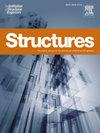Experimental and mesoscopic modeling numerical researches on steel fiber reinforced concrete slabs under contact explosion
IF 3.9
2区 工程技术
Q1 ENGINEERING, CIVIL
引用次数: 0
Abstract
This paper presents experimental research on the damage characteristics of steel fiber reinforced concrete slabs (SCS), steel fiber reinforced concrete slabs mixed with fly ash (CFS), and steel fiber reinforced concrete slabs mixed with fly ash and slag (CFSS) under contact explosion loads. The findings reveal that SCS and CFS exhibit crater damage on the top surface, spalling failure on the bottom surface, and certain damage cracks under the same contact explosion load. Additionally, the CFSS displays crater and spalling damage along with a through-hole at the center. Comparative analysis demonstrates that CFS offers the best explosion resistance properties. A reliable three-dimensional mesoscopic modeling using PYTHON and ABAQUS is established to analyze the dynamic response of the CFS, emphasizing its dependence on fiber volume. Furthermore, the study evaluates energy changes in the matrix and steel fiber to understand their impact on the slab's damage dimensions under contact explosion. Results indicate that the mesoscopic modeling effectively reflects structure damage and failure behavior under explosive super dynamic loads. Specifically, for CFS, with a steel fiber volume of 1.3%, the internal energy and stress generated by steel fiber are maximized, resulting in the smallest damage dimension under contact explosion and the best explosion-resistant effect. This research provides valuable insights for guiding the design of explosion-resistant structures and their deployment in concrete engineering applications.接触爆炸条件下钢纤维加固混凝土板的实验和介观建模数值研究
本文介绍了钢纤维加固混凝土板(SCS)、掺粉煤灰的钢纤维加固混凝土板(CFS)和掺粉煤灰和矿渣的钢纤维加固混凝土板(CFSS)在接触爆炸荷载下的破坏特征实验研究。研究结果表明,在相同的接触爆炸荷载下,SCS 和 CFS 的顶面出现凹坑破坏,底面出现剥落破坏,并出现某些破坏裂缝。此外,CFSS 在出现凹坑和剥落损坏的同时,中心还出现了一个通孔。对比分析表明,CFS 具有最佳的抗爆性能。利用PYTHON 和 ABAQUS 建立了可靠的三维介观模型来分析 CFS 的动态响应,强调其与纤维体积的关系。此外,研究还评估了基体和钢纤维中的能量变化,以了解它们在接触爆炸下对板坯损伤尺寸的影响。结果表明,介观建模能有效反映爆炸超动载荷下的结构损伤和破坏行为。具体而言,对于 CFS,当钢纤维体积为 1.3% 时,钢纤维产生的内能和应力最大,因此接触爆炸下的破坏尺寸最小,防爆效果最好。这项研究为指导防爆结构的设计及其在混凝土工程中的应用提供了宝贵的见解。
本文章由计算机程序翻译,如有差异,请以英文原文为准。
求助全文
约1分钟内获得全文
求助全文
来源期刊

Structures
Engineering-Architecture
CiteScore
5.70
自引率
17.10%
发文量
1187
期刊介绍:
Structures aims to publish internationally-leading research across the full breadth of structural engineering. Papers for Structures are particularly welcome in which high-quality research will benefit from wide readership of academics and practitioners such that not only high citation rates but also tangible industrial-related pathways to impact are achieved.
 求助内容:
求助内容: 应助结果提醒方式:
应助结果提醒方式:


